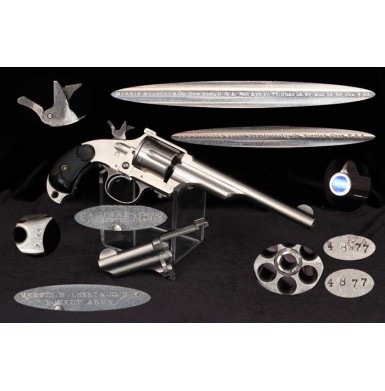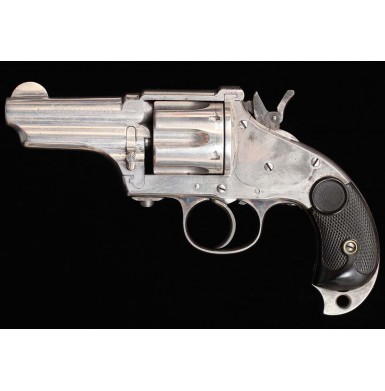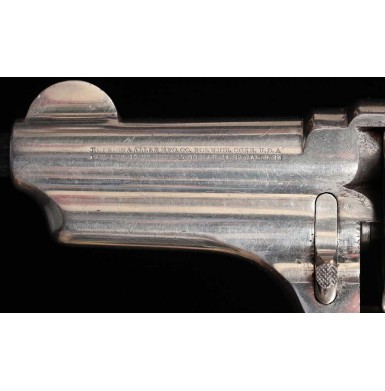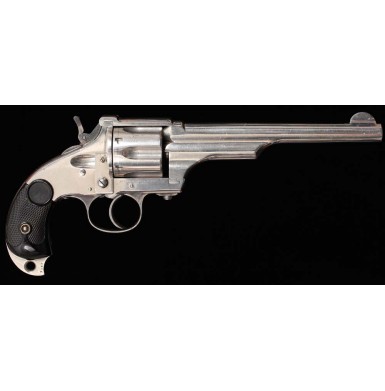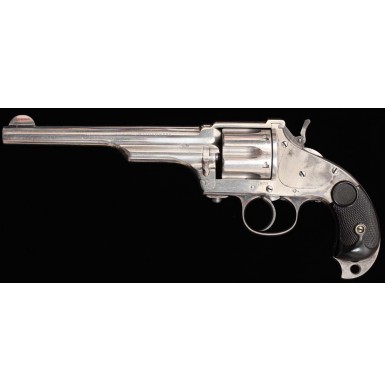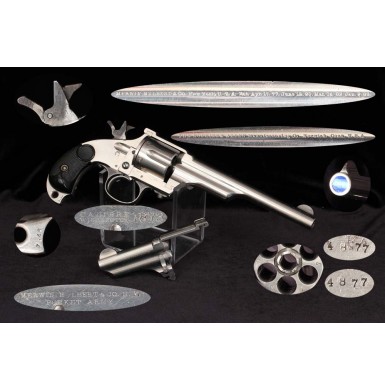Merwin, Hulbert & Company Pocket Army 2 Barrel Set - Excellent
- Product Code: FHG-1641-SOLD
- Availability: Out Of Stock
-
$1.00
The story of Merwin & Hulbert & Company is a somewhat confusing one, which may one day be more clear through additional research. The firm is probably the most famous and successful “gun making company” that never actually manufactured a single gun! Even more amazing is that the principles appear to have had no design input into the revolutionary arms that they sold! The firm had its genesis in 1859, when Joseph Merwin and his partner Edward Bray started a firearms and sporting goods store in New York City. Merwin was certainly a shrewd businessman and a visionary when it came to new and innovative firearms designs. Very quickly, Merwin became the primary (and in some cases the sole) distributor for a variety of new, metallic cartridge firearms, including those produced by Plant’s Manufacturing Company, Eagle Arms, Daniel Moore, Ballard patent firearms (as produced by Dwight, Chapman & Company and Ball & Williams), Bacon Manufacturing Company (eventually Hopkins & Allen), and eventually the Evans Repeating Rifle Company, just to name a few. Merwin also worked as a sales agent for such major firearms manufacturers as Colt and Remington, and eventually Winchester. They also imported and distributed high quality English arms. Merwin succeeded in securing several US and state military contracts during the American Civil War (primarily for Ballard rifles & carbines) and continued to expand his retail and wholesale distribution business during the course of the war. By 1866 Edward Bray left the company and Charles Simkins became a partner, leading the company to change its name to Merwin & Simkins, and later that year to Merwin, Taylor & Simkins, when Charles Taylor also joined the venture. By 1869 the short-lived partnership was dissolved, and a new partner, William Hulbert, joined Merwin, forming Merwin & Hulbert. About three years later the half-brother of Hulbert joined the partnership, and sometime around 1872 the name of the company changed again to Merwin, Hulbert & Company. The company would continue to operate under that name for the next 20 years, even though Joseph Merwin would die in 1879. During his first decade in the firearms business Merwin became an investor, partial owner and eventually controlling partner of what would become the Hopkins & Allen Company (formerly the Bacon Manufacturing Company) of Norwich, CT. He would also invest some $100,000 dollars, a significant sum at that time, in the Evans Repeating Rifle Company of Mechanic Falls, ME. Merwin’s goal appears to have been to bring revolutionary firearms market that offered superior fit, finish and operation to those of his competitors. The first products offered by Merwin, Hulbert & Company were a series of large frame revolvers, initially in single action, and eventually in double action as well. These guns were introduced in 1876 and were produced well into the 1880s, in a variety of frame and action configurations, but always in a .44 caliber format. The calibers offered included the .44 Merwin & Hulbert, .44 Russian and .44-40 (.44 Winchester Center Fire). Merwin’s hope for these large frame revolvers was to secure lucrative US or foreign military contracts, which were an essential part of any major 19th century firearms manufacturer’s business plan. The revolvers that Merwin brought to market were probably the most technologically advanced and possibly the best-built revolvers of their time, but amazingly, Merwin, Hulbert & Company did not actually manufacture them! Rather the Hopkins & Allen Company manufactured them all under Merwin’s watchful eye. This very fact is probably responsible for the lackluster success of a truly impressive product. The Merwin, Hulbert & Company revolvers utilized a revolutionary system for loading and unloading. After placing the revolver on half cock, the action was opened by depressing a spring loaded catch on the lower left side of the forward portion of the frame, and pulling a similar catch under the frame to the rear. This unlocked the action of the revolver. This allowed the user to rotate the cylinder, the forward portion of the frame, and the entire barrel to the right, and push it forward. This caused any spent cases to be ejected, leaving the unfired ones in the cylinder chambers. Fresh cartridges could then be inserted in the empty chambers. The tight mechanical tolerances of the design actually made the action “suck” itself back together, and with a simple twist, the gun was closed and locked up and ready to be put back into service. The unique design also made it possible for users of the revolvers to swap barrels in a matter of seconds, with no tools or mechanical skill necessary. As a result, Merwin & Hulbert large frame (aka “Army” or “Frontier”) revolvers were often sold with both short and long barrels. This allowed the owner to use a longer, more accurate 7” barrel for holster carry, but swap to a concealable 3 ““ barrel for situations where a more discretely carried weapon was appropriate. The earliest versions of the “Army” pattern revolver were manufactured with a squared butt profile, in single action, with an open top frame and with “scooped” cylinder flutes. As production continued and improvements were made, a top strap was added to the frame for strength, and the cylinder flutes were changed to the more traditional flutes that run from the face of the cylinder back towards the rear, without the scooped out profile. The guns were also made available with a more concealable “bird’s head” butt with a metal “skull cracker” projection on the bottom. These “bird’s head” guns with a double action mechanism and were marketed as “Pocket Army” revolvers. Merwin also introduced a relatively inexpensive “punch dot” engraving system that made embellished and highly decorated guns less costly, and more easily within the reach of average customer. Despite the revolutionary designs and meticulous attention to fit and finish, Merwin, Hulbert & Company had only moderate success with their large frame handguns. This appears to be due to the fact that the guns were marked not only with the Merwin, Hulbert & Company name, but also with the name of the actual manufacturer, Hopkins & Allen. Had the source of production remained a secret, the Merwin, Hulbert & Company “Frontier Army” revolvers may well have eclipsed the Colt Single Action Army as the most successful handgun in the west. However, Hopkins & Allen had made a name for themselves in the manufacture of inexpensive, low to mid quality arms, and even though the Merwin & Hulbert arms were anything but low to mid quality, the association with Hopkins & Allen severely hampered sales. As Art Phelps opined in his book, The Story of Merwin Hulbert & Co. Firearms, “if Merwin would have insisted and prevailed upon the Hopkins and Allen Co. partners to keep their cheap name off his most perfect guns ever made”, things would have worked out much differently for Merwin, Hulbert & Company. Examples of the Merwin, Hulbert & Company Army revolvers were even tested by the US Ordnance Bureau and found to be superior on number of point to the Colt M-1873 then in service, but no contracts were ever forthcoming. Joseph Merwin did eventually manage to obtain a Russian contract for “three ship loads’ of his Army revolvers, but the Russian’s defaulted and never paid, resulting in not only the loss of the cash, but also of the revolvers that had already been shipped! In the end, as Merwin, Hulbert & Company historian and author Art Phelps notes, Joseph Merwin “died of a broken heart”. Between his failure to make his guns the success they should have been, the duplicity of the Russian’s in their dealings with him and the los of his $100,000.00 investment in the Evans Repeating Rifle Company when it failed, Merwin appears to have finally succumbed. Even though his partners continued to operate the company until the early 1890’s, their success was limited, and they appear to have achieved greater acceptance of their medium frame, .38 caliber double action pistol than they ever did with their large Frontier Army series. Interestingly, those who really appreciated fine firearms in the late 19th century developed a real affinity for their high quality products. Merwin & Hulbert arms were owned or carried by number of famous frontier lawmen and notables, including Texas Ranger Frank Hamer (who ambushed and killed Bonnie & Clyde) carried a medium frame seven-shot .32 Merwin, Hulbert & Company DA revolver. Pat Garrett (the killer of Billie the Kid) was presented with an inscribed .38 Medium Frame Merwin, Hulbert & Company revolver in September of 1881 from the “grateful citizens of Lincoln County”, and Diamond Dick of Buffalo Bill’s Wild West Show carried a Merwin, Hulbert & Company revolver as well. More notorious frontiersmen known to have owned and carried Merwin, Hulbert & Company revolvers include Bob Dalton, Sam Bass, and John Wesley Hardin, just to name a few. Even Theodore Roosevelt, probably one of the most gun savvy outdoorsmen of the late 19th century gave a number of Merwin, Hulbert & Company revolvers as gifts during his lifetime.
Offered here is an EXCELLENT condition example of a Merwin, Hulbert & Company “Pocket Army” Revolver 2-Barrel Set. The “Pocket Army” was introduced in 1883 and remained in production through the 1880’s. It is not clear exactly how many were produced, due to an erratic serial numbering system and an 1891 fire that destroyed all of the Merwin, Hulbert & Company records. It is believed that only a few thousand of the revolvers were produced. This is a 3rd model gun, with a top strap and traditional cylinder flutes, and is made with the double action trigger mechanism. Not only does the gun retain its original, matching number 2nd factory barrel, but also has the desirable feature of a folding hammer spur. The right side of the frame is marked in two lines below the cylinder: MERWIN, HULBERT & CO. N.Y. / POCKET ARMY. The left side of the frame is crisply marked in two lines, below the cylinder: CALIBER / WINCHESTER followed by a much larger 1873, indicating the revolver is chambered for the .44 Winchester Center Fire cartridge (also known as the .44 WCF or .44-40). The top of the 7” round barrel is marked: MERWIN HULBERT & CO. New York, U.S.A. Pat. Apr. 17, 77. June 15, 80. Mar. 14, 82. Jan 2, 83.. The left side of the barrel is also marked in a single line: THE HOPKINS & ALLEN Manufacturing Co. Norwich, Conn. U.S.A.. The matching 3 1/4” barrel that also accompanies the revolver is marked in two lines on the right hand side: HOPKINS & ALLEN MFG. CO. NORWICH, CONN. U.S.A. / PAT. APR. 17, 77 JUNE 15, 30 MAR. 14, 82 JAN. 9, 88 and omits any mention of Merwin, Hulbert & Company at all. All of the markings are very crisp and clear, and completely legible. The serial number 7848 is present on the right side of the exposed “skull cracker” portion of the bird’s head grip. Like the majority of Merwin & Hulbert arms, the gun is assembly numbered on the major parts. In this case the frame under the grips, on the rear of the and on the lower rear lug of each barrel web is 4877. The right grip panel is also scratch numbered with the same assembly number on its interior. Overall, the revolver retains about 93% of its original nickel finish. There is some very minor flaking and some tiny areas of bubbling scattered over the entire gun, The most noticeable area of finish loss is some thinning and loss on the side plate on the left side of the gun. This appears to be the result of rubbing and may be an indicator of holster or carry wear. There is also a small area of minor surface bubbling on the left side of the 7” barrel, about 1” forward of the cylinder. As would be expected, there is a small amount of minor pinprick flaking on both barrels at the rear frame juncture and at the muzzle. There is also a light turn ring on the cylinder. Any of the areas where small amounts of nickel have flaked now show a lightly freckled and oxidized patina. Otherwise, the revolver shows only the usual minor surface scuffs and light scratches from handling, use and storage. The overall condition of the revolver and its finish is clearly indicated by the photos below. As is typical of 19th century nickel finishes, the finish shows some minor frosting and dulling from age. The both bores of the revolver (3 1/4” and 7”) rate about NEAR EXCELLENT. They are both mostly bright with fine, crisp rifling. Both bores show some scattered frosting and lightly scattered pinpricking along their lengths, mostly in the grooves, as well as some very lightly scattered patches of minor pitting as well. The 7” barrel shows slightly more pitting and use than the shorter barrel does. The folding spur hammer retains about 30%+ or its original case hardened colors, which have dulled and faded to a smoke gray patina, with some patches of colored mottling and silvered high edge wear. The hammer body is marked in two lines on the right hand side: Pat’d / Jan. 27, 85. The trigger guard retains about 80% of its original vivid case coloring, which is most evident on the wider web portions at the front and rear where the guard meets the frame of the revolver. The revolver is mechanically excellent and the double action mechanism works flawlessly in both double and single action modes. The revolver cycles, indexes, times and locks up perfectly. The locking system of the revolver works flawlessly as well, with the forward portion of the frame, barrel and the cylinder unlocking, rotating and sliding smoothly forward as they should. The revolver mechanism retains only minimal “suction”. This may be the result of the gun being a 2-barrel set and having the barrels changed on a regular basis. The mechanism locks the gun up securely, exactly as it should. All of the screws remain crisp and sharp with practically no slot wear. The innovative sliding loading gate functions smoothly and opens and closes exactly as it should. The two-piece, black hard rubber grips are in equally EXCELLENT condition, with no breaks, cracks, chips or repairs. They still retain crisp checkering and fit the frame perfectly. They are clearly original to the revolver and the inside of the right grip is scratch numbered with the same assembly number as found throughout the pistol.
Overall this is a really EXCELLENT condition example of the scarce and popular Merwin, Hulbert & Company Double Action Pocket Army Revolver 2-Barrel Set. The revolver is in the most popular and desirable caliber, .44-40 and retains both original and matching factory barrels. The gun also has the very desirable folding hammer spur that made the short-barreled configuration even more concealable. These large frame Merwin, Hulbert & Company revolvers saw use by the good, bad and the ugly during America’s westward expansion and are an important part of old west firearms history. Every serous collection of pistols from the American west needs at least a couple of Merwin, Hulbert & Company revolvers in it, and this one would be a fantastic addition. Don’t miss your chance to own an exceptional quality Merwin, Hulbert & Company, all matching, 2 barreled set Pocket Army before they become even more difficult to find.
SOLDTags: Merwin, Hulbert, Company, Pocket, Army, 2, Barrel, Set, Excellent

